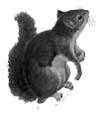|
Western Low Conifer
While enjoying these lowland forests along the highway stop, look and
listen for spotted, barred and great horned owls, ruffed grouse, band
 tailed pigeon, Vaux's swift, pileated woodpecker, Steller's jay, winter
wren, golden-crowned kinglet, Swainson's thrush, red-legged frog,
ensatina, Townsend's chipmunk, Trowbridge's shrew and long-legged
myotis.
tailed pigeon, Vaux's swift, pileated woodpecker, Steller's jay, winter
wren, golden-crowned kinglet, Swainson's thrush, red-legged frog,
ensatina, Townsend's chipmunk, Trowbridge's shrew and long-legged
myotis.
Montane Mixed Conifer
This mid-elevation zone stretches from 2,000' to 4,000'. Inhabiting
birds include Barrow's goldeneye, red-breasted sapsucker, mountain
chickadee, red-breasted nuthatch, winter wren, dipper, MacGillivray's
warbler, cascades frog, roughskinned newt, mountain beaver, elk and mule
deer.
Subalpine Parkland
Typical inhabitants include blue grouse, rufous and calliope
hummingbirds, three-toed woodpecker, Clark's nutcracker, hermit thrush,
Townsend's warbler, hoary marmot, wolverine and pacific giant
salamander.
Alpine Grass and Shrublands
A few hardy species use this high-elevation zone including white-tailed
Ptarmigan, black swift, common raven, horned lark, American pipit,
mountain goat, and long-toed salamander.
|

Eastside Mixed Conifer
This upper-elevation zone on the eastside of the mountains is home to
the western screech-owl, common nighthawk, Hammond's and dusky
flycatchers, pygmy nuthatch, house wren, big brown bat, masked shrew,
red squirrel, deer mouse and white-tailed deer.
See if you can identify what zone you are in by
the animals and plants you observe.
Notice gradual zone changesyou should be able to
predict what animals you may see from the types of vegetation
surrounding you.
|
Watershed lifecycles
Water is the life force of the North Cascades. It
falls from the sky, melts from glaciers, trickles off mountains,
replenishes lakes and flows to the sea.
Within the Puget Sound Watershed, the Skagit is the
largest and most bountiful river. With its 2,900 streams, the Skagit
River Watershed accounts for one third of the water that empties into
Puget Sound.
All five species of salmon and four species of
anadromous (sea-run) trout begin life in the cool gravel bottoms of the
Skagit watershed where they feed on a healthy macroinvertebrate
population. These tiny aquatic insects may not have a spine but they are
the backbone of the river ecosystem.
On average, 330,000 pink and 30,000 coho salmon
return yearly to spawn in the Skagit. In odd-numbered years like 2001,
as many as 40,000 chum salmon may return. The 2001 run brought 894,000
pink, approximately 75,000 Coho and 62,262 Chum.
The Skagit and other watersheds of the North Cascades
are habitats that attract one of the largest winter gatherings of bald
eagles in the lower 48 states. More than 500 birds spend the winter
along the river. The eagles travel here to feed on spawned-out salmon
carcasses that sustain them through the winter. In turn, the eagles help
cleanse the river and return the nutrients in the fish to the land.
This key life cycle reminds us that nature's
recycling and clear, clean water are critical to survival.
|



 tailed pigeon, Vaux's swift, pileated woodpecker, Steller's jay, winter
wren, golden-crowned kinglet, Swainson's thrush, red-legged frog,
ensatina, Townsend's chipmunk, Trowbridge's shrew and long-legged
myotis.
tailed pigeon, Vaux's swift, pileated woodpecker, Steller's jay, winter
wren, golden-crowned kinglet, Swainson's thrush, red-legged frog,
ensatina, Townsend's chipmunk, Trowbridge's shrew and long-legged
myotis.